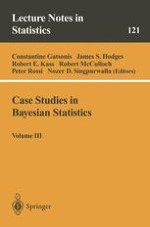1997 | OriginalPaper | Buchkapitel
Bayesian Inference for the Best Ordinal Multinomial Population in a Taste Test
verfasst von : Balgobin Nandram
Erschienen in: Case Studies in Bayesian Statistics
Verlag: Springer New York
Enthalten in: Professional Book Archive
Aktivieren Sie unsere intelligente Suche, um passende Fachinhalte oder Patente zu finden.
Wählen Sie Textabschnitte aus um mit Künstlicher Intelligenz passenden Patente zu finden. powered by
Markieren Sie Textabschnitte, um KI-gestützt weitere passende Inhalte zu finden. powered by
Sensory experiments are used by industries to select the best product out of a set of similar products. In a taste-testing experiment 36 panelists were asked to rate 11 entrees of a military ration on a 9-point hedonic scale. An objective of the study was to select the best entree and to estimate the probability of at least a neutral response from the selected entree. Our probabilistic structure starts with the multinomial model. Let $${\underset{\raise0.3em\hbox{$\smash{\scriptscriptstyle\thicksim}$}}{n} _i} = ({n_{i1}}, \ldots ,{n_{iJ}})$$’ be the cell counts and $${\underset{\raise0.3em\hbox{$\smash{\scriptscriptstyle\thicksim}$}}{p} _i} = ({p_{i1}}, \ldots ,{p_{iJ}})$$’ be the cell probabilities, i = 1,…,I. Then, given $${\underset{\raise0.3em\hbox{$\smash{\scriptscriptstyle\thicksim}$}}{p} _i}$$, we take independent multinomial distributions for the $${\underset{\raise0.3em\hbox{$\smash{\scriptscriptstyle\thicksim}$}}{n} _i}$$, and nonidentical Dirichlet distributions for the $${\underset{\raise0.3em\hbox{$\smash{\scriptscriptstyle\thicksim}$}}{p} _i}$$. A priori each population has a possible nonzero probability of being the best. Using the simple tree order, we obtain the most probable population a posteriori under three criteria. Let $${\mu _i} = \sum\nolimits_{j = 1}^J {j{p_{ij}}} ,{\text{ }}{\sigma _i} = {\left\{ {\sum\nolimits_{j = 1}^J {{p_{ij}}{{\left( {j - {\mu _i}} \right)}^2}} } \right\}^{1/2}}{\text{ and }}{v_i} = {\sigma _i}/{\mu _i}$$ be the mean, standard deviation and coefficient of variation of the ith population, i = 1,…, I. We select the population with the largest mean, the population with the smallest standard deviation, or the population with the smallest coefficient of variation. Selection and estimation occur simultaneously. Our method is sampling based, and uses Monte Carlo integration accommodated by rejection sampling. Chicken was judged the best entree by the three criteria, and the posterior probability of at least a neutral response for chicken was.78.
